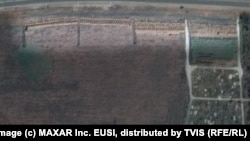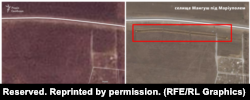New satellite imagery indicates hundreds of newly dug graves west of the besieged Ukrainian port of Mariupol, and a local official said thousands of bodies may be buried there.
The finding by Schemes, an investigative unit of RFE/RLs Ukrainian Service, comes after weeks of bombardments and brutal street-to-street fighting that the mayor of Mariupol says have killed some 20,000 people.
The Sea of Azov port, which has become a symbol of Ukrainian resistance, has been a priority target for Russian forces since launching the invasion on February 24, due in part to its port and industrial facilities -- including two major steel and metal works factories.
Mariupol is one of the biggest cities in the Donbas, a sprawling part of southeastern Ukraine that Russia says it is seeking to control in its entirety. The city itself is being defended by a dwindling force of Ukrainian marines and soldiers from the Azov Regiment.
Satellite imagery taken by the private company Maxar Technologies between March 23 and April 3 and obtained by Schemes shows an excavated trench, containing what appear to be dozens of narrow pits, dug into the ground near a cemetery in Manhush.
Located about 20 kilometers west of Mariupol, the town remains under Russian military control.
The trench, which is more than 300 meters long, was dug sometime between March 23 and March 29, based on a comparison of imagery from different dates.
In a more recent image, dated April 9, the trench has been widened further.
Petro Andryushchenko, an adviser to Mariupol’s mayor, told reporters that Russian troops had been collecting bodies from the city’s streets and initially placing them in industrial refrigerators. They were then packed into trucks and shipped to mass graves, he said.
“How many and how to count them? We do not know. Thousands must be there… But at last we found out where at least some of the dead are taken from Mariupol,” Andryushchenko said.
Mariupol’s City Council, meanwhile, said in a post on Telegram on April 21 that Russian forces had buried between 3,000 to 9,000 people in Manhush.
Mariupol is also a strategic target for Russian forces because of its location along a coastline that, if fully controlled by Russia, would give it a “land bridge” to Crimea, the peninsula that Russia seized from Ukraine in 2014.
Currently, Russia’s only access to the peninsula by road or rail is a 19-kilometer-long bridge across the Kerch Strait.
The city itself is almost entirely occupied by Russian forces, with the Azovstal steel plant currently serving as the last redoubt for Ukrainian troops along with an estimated 1,000 civilians.
The situation at the factory remains critical, Major Serhiy Volynskiy, commander of the 36th Separate Marine Brigade, told Schemes, with food, water, and ammunition running low.
On April 21, Russian President Vladimir Putin effectively declared victory over the city, and he ordered Defense Ministry Sergei Shoigu not to storm the factory but to set up a siege blockade instead.












